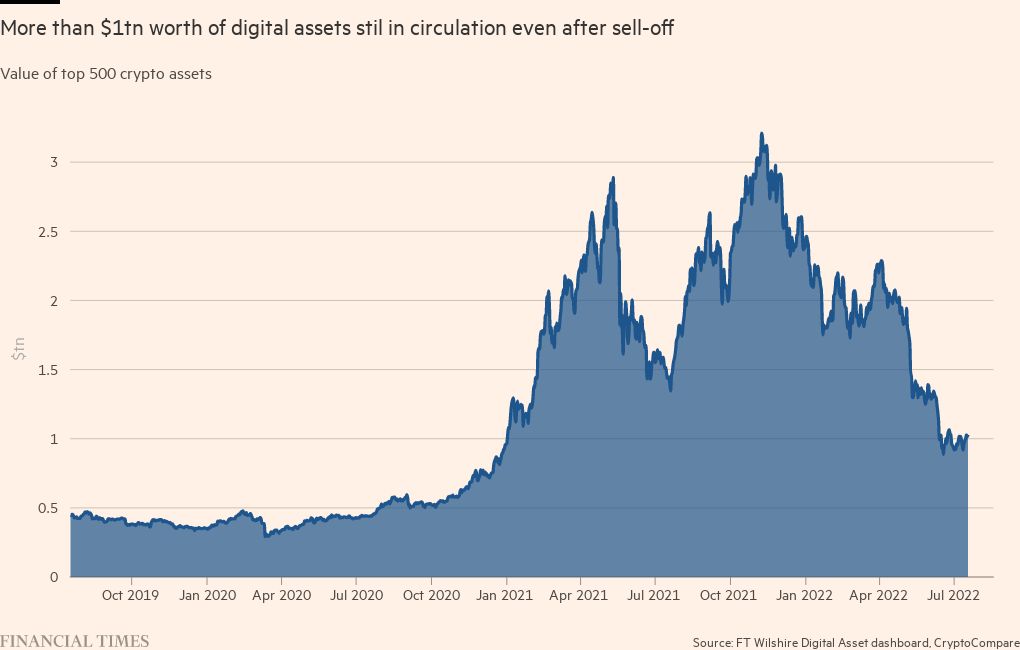The crypto crash has important lessons for asset managers

Roula Khalaf, Editor of the FT, selects her favourite stories in this weekly newsletter.
The writer is chief executive of Schroders
Bitcoin’s price collapse will raise satisfied smiles from sceptics. They can congratulate themselves for being right on the valuations, at least for now.
They are right that over-exuberance is a danger — history has made that point several times. But the birth and growth in popularity of cryptocurrencies raise a further point to consider: is the investment industry failing to make the case for traditional investments? Are we missing a trick?
Around 300mn people hold crypto assets, industry estimates from cypto.com suggest. And even after the sell-off this year, there are still $1.1tn worth of digital assets in circulation.
These dramatic numbers reflect the conversations we witness every day, in pubs, on social media or in the back of cabs. A lot of people have been inspired to buy into an untested, unregulated, highly volatile new asset. This has proved disastrous for some, especially for those who bought at the peak.
If, despite these obvious drawbacks, crypto and digital assets can sell themselves so well, there are lessons in the phenomenon for asset managers.
Ironically, it is blockchain, the technology that underpins cryptocurrencies, that could be the catalyst for change for the traditional investment industry. In fact, it is probably the reason we may have already passed “peak fund”. The signs are increasingly clear that the mutual fund market is not going to get bigger than it currently is. Money is shifting to personalised portfolios and this will only increase with ledger technology.
Cryptofinance

Critical intelligence on the digital asset industry. Explore the FT’s coverage here.
In the decades ahead, new types of bespoke investment products could become more common than the unit trusts and open-ended investment companies that dominate today.
Blockchain technology will help provide access to exciting, more tangible assets. A new breed of asset management firm with broad capabilities will make it simple to invest in the world around us. A shopping centre, for example, could be carved up and slivers of it sold to local investors, perhaps its own shoppers.
The ledger technology of blockchain would record ownership and effectively create a trading platform. Buying and selling is easy and transparent, and the asset is tangible. It could be blended as part of a portfolio to ensure some diversification and to achieve the best outcome for the investor.
Tangibility is key, as is a connection with the underlying investments. The demand for disruptive technology stocks during successive lockdowns has shown this, as has the popularity of crowdfunding over a longer period. Investors want to know the story of their investments and ensure they match their own values. They especially want their portfolios to be personal to them. Use of blockchain technology can aid this journey.
Ledger technology offers us much more. Our traditional back office operations could see transformative improvements. Transferring asset ownership with a single click is preferable to the current multi-step, multi-day trading process that is required, for instance.
Investors should reap the benefit of this wave of democratisation. Assets once out of reach will become tokenised, easily accessible and affordable.
In the not too distant future, investors will probably hold more of their investments in their digital wallet than they do in funds. This could become a reality within my career.
The need for asset managers that actively manage investments will grow in this democratised world. The plethora of new investing options will need to be researched to assess their potential and their impact. Portfolios will need to be balanced and structured to meet the goals of their owners.
The question is whether the industry can embrace this challenge. Not every company is ready for the journey and not all will make it. Those already bringing together public and private markets on their platforms will be best placed.
The key is to forge strong connections with those already immersed in the world of cryptocurrencies. The crypto industry is at a similar stage to the hedge fund industry 20 or 30 years ago. While it remains unruly, some platforms are attempting to harness extreme volatility to try and offer more predictable returns.
Many investors have turned to crypto. Others have chosen to crowdfund companies they believe in. The industry can meet this demand for personalisation and broad choice by embracing blockchain, and by being open to the ways in which new asset classes can work in portfolios.
If we fail in this aim, even more investors will be lured away to the next wave of unorthodox and untested investments.

Comments